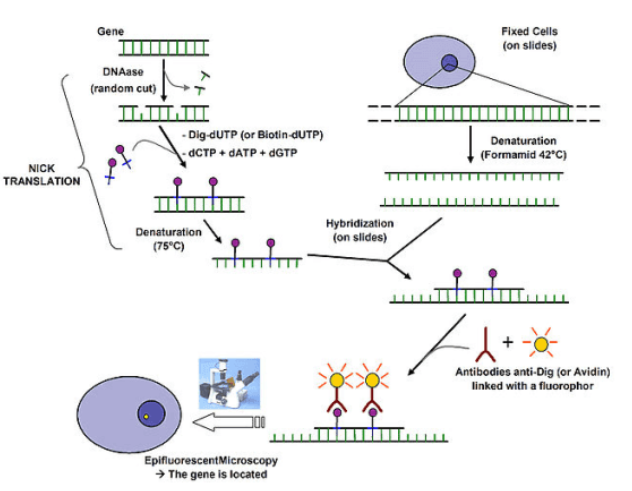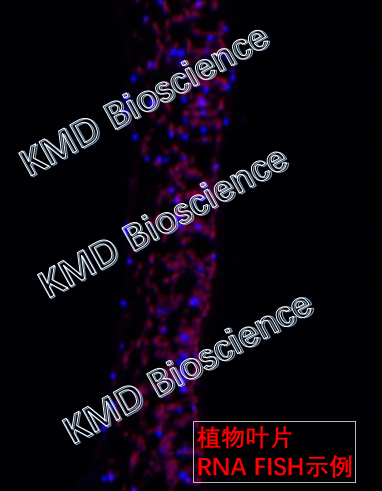2023-05-12 Hits(568)
1.Concept of Fluorescence In Situ Hybridization
Fluorescence in situ hybridization (FISH) is a non-radioactive in situ hybridization technique and a novel combination of molecular biology and cytogenetics. Fluorescence in situ hybridization is a technique for the qualitative, quantitative or relative positioning analysis of DNA using a fluorescence detection system. The basic principle is to hybridise a known fluorescein, biotin or digoxigenin-labelled nucleic acid probe with the DNA of the sample to be tested, based on the complementarity of the DNA sequence, to form a detectable double-stranded nucleic acid hybridization.

Fig. 1: schematic diagram of fluorescence in situ hybridization principle
2. Fluorescence In Situ Hybridization Probe Labelling Methods
There are two methods of fluorescent labelling of fluorescent in situ hybridization probes. The indirect labeling method is to label the DNA probe with biotin, and the direct labeling method is to directly combine fluorescein with the probe nucleotide or pentose phosphate skeleton. The detection steps of direct labeling method are simple, but the sensitivity is not as good as that of indirect labeling method because the signal cannot be amplified
3. Types of Fluorescent In Situ Hybridization Probes
(1) Double-stranded DNA probes are widely used, easy to use, and are not easily degraded, once successfully cloned, a large number of labelled probes can be obtained using the same amplification and labelling procedures.
(2) Single-stranded DNA (ssDNA) probes are stable, easier to use, more specific, resistant to RNase, better in tissue penetration and free from self-hybridization.
(3) RNA probes (ribosomal probes) have higher thermal stability, better tissue penetration, higher specificity and less effect of RNase.
(4) Synthetic oligonucleotides are economical, stable, specific, resistant to RNase, good tissue penetration and reproducibility.
4. Advantages of Fluorescence In Situ Hybridization Technology
Fluorescence in situ hybridization has advantages over other hybridization methods:
(1) FISH is non-radioactive element labelling and is safer;
(2) The experimental cycle of FISH is short and multiple sequences can be detected simultaneously;
(3) The sensitivity of FISH is comparable to that of radioactive probes because the hybridization signal is enhanced by multiple immunochemical reactions.
5. Applications of Fluorescence In Situ Hybridization
Fluorescence in situ hybridization is widely used in gene expression analysis, chromosome structure and number abnormality detection, rapid clinical diagnosis of cancer, human prenatal diagnosis and other fields, and has very important application value.
6. KMD Bioscience can Provide Customers with High-Quality Fluorescence In Situ Hybridization Services
KMD Bioscience has been dedicated to cell biology research for many years and has experienced technical service personnel of fluorescence in situ hybridization (FISH), and has built a complete FISH technical service platform. We can provide one-stop FISH technical services including probe design, sample processing, hybridization detection, gene expression research and data analysis, and have standardized and standard detection procedures, thus ensuring the accuracy of experimental results and reducing false positives and false positives. KMD Bioscience can also custom and synthesize a wide range of probes, including most plants, animals and microorganisms, with >150kb of custom probes, high specificity and low error rate; using fluorescent in situ hybridization, KMD Bioscience can also provide monoclonal origin identification services.

Fig. 2: FISH example for plant leaves
7. Introduction of Fluorescence In Situ Hybridization Service Process
KMD Bioscience can provide fluorescence in situ hybridization services, the main technical processes are as follows: probe design and synthesis, sample processing, in situ hybridization experiments, imaging and photography, result analysis and project reporting.
7.1 Probe Design and Synthesis
7.1.1 Ready-to-use probes can be hybridised directly, while non-ready-to-use probes need to be diluted with the hybridization solution at a ratio of 1:1:1:50, denatured at 85°C for 3 minutes and equilibrated at 37°C for 5 minutes.
7.2 Sample Processing
7.2.1 Dewaxing and rehydration, paraffin sections immersed in xylene dewaxing, 2 times for 10 minutes each;
7.2.2 Slices are sequentially passed through 100%, 85% and 75% ethanol for 3 minutes each and PBS for 3 minutes;
7.2.3 Slides are digested with pepsin digestive solution at 37°C for 15-30 minutes, and washed with PBStwice for 3 minutes each time;
7.2.4 Pre-hybridization: remove the hybridization solution from the refrigerator 30 minutes in advance to restore it to room temperature, and the hybridization solution was added dropwise for incubation at 55 C for 1 hour..
7.3 In Situ Hybridization Experiment
7.3.1 Taking out the pre-hybridized slices, removing excess liquid, adding the probe dropwise to the slices, cover the tissue completely and place them in the hybridiser overnight at 37°C;
7.3.2 Washing the slices 3 times for 5 min each in 2 x SSC (0.1% NP-40);
7.3.3 Adding 20ul of DAPI-Antifade Solution dropwise to seal the slides and incubate for 20min away from light.
7.4 Imaging and photography
Photographs of the results of the fluorescence in situ hybridization experiments for different samples of KMD Bioscience:

Fig. 3: Fluorescence in situ hybridization photographs of different samples
7.5 Results Analysis and Project Report
KMD Bioscience delivers: the remaining probes, sections and samples, original hybridization imaging photographs, and a detailed report (including a full procedure and analysis of the results).
Technical experts from KMD Bioscience will provide professional one-to-one customised solutions and assays for different species of samples, from probe design, chromosome/cell/bacterial generation/culture to presentation of results, with a full customised FISH service and delivery of a full report and photographic images.